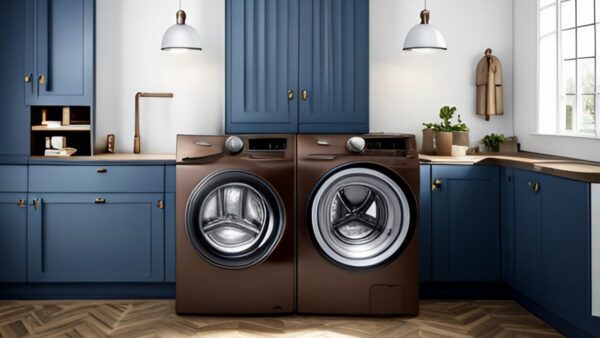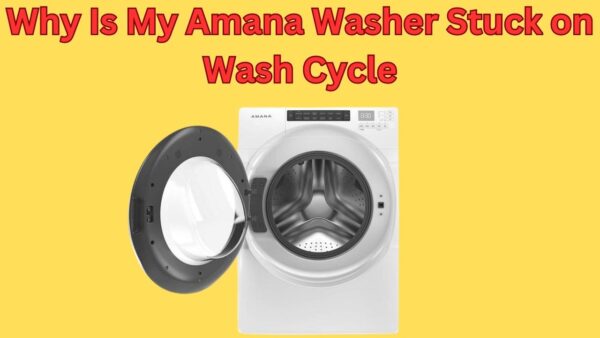Is your Samsung washer making a weird clicking noise during the spin cycle? You’re not alone – over 20% of washer owners face similar issues, which can be both annoying and confusing.
The good news? Fixing it could be simpler than you think! From loose coins hidden in the drum to a massive issue like a damaged drive belt, we’ll cover everything you need to know to pinpoint the problem.
Get ready to tackle these washer woes with essential tips that could be totally game-changing for your laundry routine!
This guide will break down the 15 most common causes of a Samsung washer making clicking noises when spinning, along with how to fix them. Additionally, we’ll provide tips to prevent this issue from coming back.
Why Does my Samsung Washing Machine Make a Knocking Sound?
Unplug your washer for about 5 minutes and then plug it back in, this should reset your Samsung washer.
Hearing a Samsung washer making clicking noise when spinning can be annoying, but the fix might be simpler than you think. Here’s what to do
- Check for Loose Objects Inside the Drum
A loose coin, pin, or button in the drum can create a Samsung washer clicking sound. Remove any items that don’t belong, ensuring no small objects cause that noise.
This simple step can be a game-changing solution to avoid damage and regain peace during washing cycles.
- Inspect the Washer’s Balance
When a Samsung washer shakes violently during spin cycle, it may not be level. Use a level tool to adjust the washer’s feet and stop it from moving excessively. A stable washer reduces clicking noises and extends the life of your appliance–a massive win for any household.
- Clear Debris from the Pump Filter
A clogged pump filter might be the cause of a Samsung washer making noise when spinning. Turn off the washer, access the filter, and clean out any dirt or debris. This quick fix is essential for quieter, smoother spinning.
- Check for Worn-Out or Damaged Parts
A worn-out drum bearing or loose belt could be why your Samsung washing machine making clicking noise. Carefully inspect these parts and replace them if necessary. It’s a revolutionary move to save costs on bigger repairs down the road.
- Look for Issues in the Drying Cycle
If a Samsung dryer making clicking noise when spinning is involved, check the drum rollers. Worn rollers can create repetitive noises during the spin. Replacing them can deliver a massive improvement and put an end to constant clicking.
Meaning of Sound in Samsung Washers
If you’ve noticed a Samsung washer making clicking noise when spinning, you’re not alone. These clicks, hums, or rattles might seem worrying, but they usually have straightforward explanations.
Here are five common sounds and their meanings to help you address potential issues easily.
Knowing these can be game-changing for keeping your washer running smoothly.
1. Clicking During Spinning
One of the most common sounds is a clicking noise during the spin cycle. This type of Samsung washer making clicking noise when spinning often comes from loose objects like coins or buttons stuck in the drum or pump filter.
Clearing out pockets or checking the filter can solve this issue fast.
Ignoring it might lead to damage over time, so it’s essential to act quickly. A simple fix like this can spare you massive repair costs later.
2. Rattling or Vibrating Sounds
A rattling sound could mean an improperly balanced load of laundry. Washing only a few items or unevenly placed clothes can cause the machine to shake, especially when spinning. Reorganizing the load evenly can reduce vibrations and stop the noise.
Another cause might be loose screws or parts in the machine itself.
Hearing a rattling Samsung washer making clicking noise when spinning could signal the need for minor tightening or adjustments.
3. Loud Tapping or Knocking Noises
When laundry gets tangled, heavy items can knock against the drum and create loud tapping. This is harmless but annoying and can often be avoided by bundling similar fabrics.
If your washer is level on the floor yet still makes this sound, inspect the suspension springs, as they may be worn out.
Neglecting this sound could lead to further damage inside. Keeping your washer healthy during these moments feels almost revolutionary.
4. Buzzing or Humming Sounds
A low humming or buzzing noise usually comes from the motor or drain pump. This might occur when the machine struggles to drain water, a clog being the most frequent culprit.
Check the pump and hoses for any blockages to keep things running smoothly. If you’ve cleaned everything but still hear it, professional inspection might be needed.
Ignoring a buzzing Samsung washer making clicking noise when spinning could escalate into more massive mechanical issues.
5. Scraping or Metallic Sounds
A scraping noise often hints at a foreign object stuck between the drum and the tub. Coins, hairpins, or even zippers can cause this metallic sound, so look inside the drum carefully.
Removing these objects early is essential to preventing damage to the drum’s surface.
A scraping Samsung washer making clicking noise when spinning should always be addressed promptly.
Fixing this might just extend your washer’s lifespan significantly.

Why is Samsung Washer Making Clicking Noise When Spinning?

1. Faulty Drum Bearing
Cause:
The drum bearing supports the rear of the washing drum, and when it becomes defective due to wear and tear, it can make a loud noise, much like a clicking sound, during spin cycles.
This problem is common in washers with a significant amount of use.
“Bearings wear out over time and excessive usage, leading to a loud clicking sound during the wash cycle.”
Solution:
To rectify the issue, the faulty bearing must be replaced.
Only a qualified technician should undertake this task, as it involves disassembling several parts of the washer to access the bearing.
“Replacement of the drum bearing is a technical job and should be performed by a professional to ensure the longevity and proper function of your Samsung washer.”
2. Loose Motor Coupling
Cause:
Loose motor coupling arises typically due to improper installation, prolonged usage, or inadequate maintenance.
This mechanical failure leads to inefficient transmission of power between the motor and the machine, potentially causing significant operational disruptions.
Loose motor coupling can seriously hamper the productivity of the machine and its overall life span. It’s imperative to diagnose this problem early to avoid costly repairs.
Solution:
The solution to loose motor coupling lies primarily in regular and thorough maintenance checks. This routine ensures any signs of wear and tear are detected and addressed promptly.
It’s recommended to replace the coupling if it shows signs of excessive wear or looseness.
Use of quality, compatible parts during replacement is crucial for optimal performance. Regular maintenance and timely replacement are key to long-term machine health and productivity.
3. Unbalanced Load
Cause:
An unbalanced load typically arises when the weight or volume of items in a machine, such as a washing machine or a dryer, is not evenly distributed.
This disparity in distribution can cause erratic movements, excessive noise, and even damage to the machine over time.
This issue is more commonly seen when large, bulky items are washed or dried in machines not designed to handle such loads.
Solution:
The solution to an unbalanced load lies in accurately sorting and loading your items. For instance, ensure similar-weight items are grouped together for each wash or dry cycle.
Another useful tip is to balance large items with smaller ones to maintain an even distribution.
In the case of large, bulky items, consider using commercial laundry services to prevent damage to your domestic machines.
Always remember that taking care of your appliances now can prevent expensive repairs later.
4. Drain Pump Issues
Cause:
The issue with the drain pump could stem from various causes. Commonly, an obstruction in the pump might be the culprit, leading to inefficient draining.
Other possible causes include a worn-out pump motor or a malfunctioning pump impeller.
Solution:
To tackle this problem effectively, first, check for any obstructions in the pump and remove them. If the issue persists, the pump motor or impeller might need examination.
In such cases, it’s advisable to get a professional to inspect and potentially replace these parts to ensure your drain pump returns to optimal functioning.
5. Impeller Blade Damage
Causes of Impeller Blade Damage:
Impeller blade damage is typically the result of exposure to corrosive substances, or physical impact due to foreign objects.
Over time, the continuous exposure to aggressive fluids can lead to the corrosion of the impeller blade.
Moreover, the ingestion of solid particles or debris can inflict physical damage, causing cracks or dents on the blade.
Solutions for Impeller Blade Damage:
To prevent impeller blade damage, it’s crucial to use materials resistant to the type of fluid being pumped.
Regular inspection and maintenance of the pump system also play a significant role in identifying early signs of damage.
If damage is detected, it’s generally recommended to replace the impeller blade completely, as attempting to repair a damaged blade may lead to further issues down the line.
6. Broken Spider Arm
Cause:
The “Broken Spider Arm” typically results from excessive load or stress, often due to inappropriate use or overuse.
This is a common issue in heavy machinery where spider arms, crucial for load distribution, are subjected to substantial stress.
Overloading and improper maintenance are primary contributors to this problem.
Solution:
The best solution to a “Broken Spider Arm” is prompt and professional repair or, in extreme cases, replacement.
It’s crucial to consult with a qualified professional to assess the damage and suggest the best course of action.
Regular inspections and proper usage can often prevent such issues, emphasizing the importance of preventative maintenance in machinery.
7. Worn Out Drive Belt
Cause:
A worn-out drive belt – a common issue seen in many mechanical devices – is often the result of prolonged use, wear and tear.
This tends to result in the belt losing its grip, which in turn, compromises the overall functionality of the device it’s connected to.
This can lead to inefficiency, abnormal noises, or even a complete halt in operation.
Solution:
The solution to a worn-out drive belt is a straightforward replacement. It’s recommended to procure a new belt that matches the exact specifications of the original.
Regular inspection and maintenance can also prolong the life of the drive belt and prevent premature wear and tear.
Remember, a well-maintained machine not only runs efficiently but also ensures longevity and optimal performance.
Key Takeaway: Regular inspection and maintenance can save costly repairs and downtime.
A worn-out drive belt should be replaced promptly to prevent further damage. A well-maintained machine ensures optimal performance.
8. Agitator Directional Cogs Damage
Cause:
Agitator directional cogs, also known as agitator dogs, are a crucial component of the washing machine.
These small, plastic pieces allow the agitator to rotate in one direction and lock in the opposite direction.
Damage to these cogs typically results from overloading the washer or frequent use over time.
Overloading can strain the cogs, making them wear out prematurely, while regular use can naturally degrade them over time.
Solution:
The solution to damaged agitator directional cogs is relatively straightforward – replacement of the worn-out cogs. First, disassemble the upper part of the agitator to reach the cogs.
After removing the damaged cogs, install the new ones and reassemble the agitator.
Always remember to avoid overloading the washing machine to lengthen the lifespan of your newly installed cogs and ensure efficient operation.
Regular inspections are also recommended to catch any signs of wear and tear early.
9. Loose Tub Nut
Cause:
A loose tub nut, a common issue in plumbing, occurs when the nut that secures the drain to the bottom of the bathtub becomes loose.
This could be due to faulty installation, regular wear and tear over time, or the lack of sufficient adhesive when initially installed.
Solution:
To remedy a loose tub nut, it is paramount to first ensure the tub is empty and dry. Then using a pair of pliers, tighten the nut until it is secure again.
If the nut refuses to tighten or remains loose, it may need to be replaced. In this case, removing the old nut with a tub drain remover or a dumbbell wrench and installing a new one is recommended.
Ensure the new nut is coated with plumber’s putty before installation for a secure fit. Please consider reaching out to a professional plumber if the issue persists.
10. Damaged Drive Block
Cause:
The occurrence of a “Damaged Drive Block” is typically linked to physical imperfections on the hard drive’s magnetic layer.
These imperfections, or “bad sectors”, can be a product of physical damage, prolonged use, or even manufacturing defects.
It is essential to know that these can lead to data corruption or loss, impeding the overall functionality of the drive.
Solution:
Addressing a “Damaged Drive Block” involves a two-step process: detection and repair.
Initial detection can be achieved through built-in utilities in your operating system, which scan the drive for bad sectors.
For the repair process, disk repair tools are available which attempt to salvage information from the bad sectors and move it to a safer location on the drive.
However, consistent occurrence of damaged drive blocks can be symptomatic of a failing drive, and in such cases, it is recommended to backup all valuable data and consider replacing the drive. Remember, regular backups can save you from unexpected data loss.
11. Impaired Shock Absorber
Cause:
The impairment of a vehicle’s shock absorber is often due to prolonged use, poor road conditions, or an accident.
This impairment can significantly affect the car’s handling and braking, making it less safe to operate.
Solution:
To rectify an impaired shock absorber, it’s essential to have it inspected and replaced by a professional mechanic.
Regular maintenance can also prevent this issue, improving the overall lifespan of your vehicle’s suspension system.
Remember, a smooth ride isn’t just about comfort; it’s also about safety.
12. Snapped Suspension Spring
Cause:
A snapped suspension spring typically results from extended use, poor maintenance, or the strain of carrying heavy loads.
The suspension springs, designed to absorb impact and ensure a smooth ride, can fail under these excessive stresses.
The metal’s degradation over time, coupled with harsh road conditions, can also lead to this unfortunate circumstance.
Remember, regular inspection and maintenance can significantly prolong the life of your suspension springs.
Solution:
Once a suspension spring snaps, the only viable solution is replacement.
Seeking professional help is advised, as the process of replacing a suspension spring involves specialized tools and knowledge.
Avoid driving your vehicle with a broken suspension spring— it can lead to serious accidents. Always prioritize safety and consult with a professional mechanic immediately.
13. Defective Door Lock
Cause:
The primary cause of a defective door lock might trace back to various reasons such as general wear and tear, misaligned door latch, or a broken key in the lock.
A frequent use of the door lock over time can cause its internal mechanics to degrade, resulting in a faulty door lock.
Similarly, a misaligned door latch can lead to difficulty in locking and unlocking. Lastly, a broken key in the lock can cause it to jam, making it defective.
Solution:
The solution to a defective door lock depends on the root cause. If there’s a misalignment issue, adjusting the strike plate can solve the problem.
In case of degradation due to wear and tear, a comaytag vs samsungmplete lock replacement may be necessary. If a key is broken inside the lock, a locksmith can extract the broken piece professionally.
Always consult with a professional locksmith before attempting any repairs yourself to ensure safety and prevent further damage.
14. Broken Stabilizer
Cause:
The cause of a broken stabilizer link is usually due to excessive wear and tear or harsh driving conditions.
Over time, the link can deteriorate and eventually snap, leading to a noticeable decrease in handling performance.
Potholes, off-road driving, or accidents can also cause immediate breakage.
Solution:
To resolve the issue, the broken stabilizer link must be replaced. This is a job that requires the skills of a professional mechanic.
It’s important not to ignore a broken stabilizer link as it can lead to other more serious vehicle problems.
Regularly servicing your vehicle, and addressing any issues as soon as they arise, is the most effective way to prevent breakdowns and expensive repairs.
15. Malfunctioning Rotor Assembly
Cause:
The most common cause of a malfunctioning rotor assembly is often due to wear and tear caused by continuous operation.
Other factors such as improper installation or the use of incorrect parts can also lead to issues.
In certain scenarios, environmental conditions like extreme heat or cold can contribute to the malfunction.
Solution:
The solution involves a comprehensive inspection and replacement of worn-out parts. Remember to use only approved replacement parts to ensure compatibility and durability.
If environmental conditions are a factor, consider implementing protective measures or relocating the machinery to a more suitable location.
Preventive maintenance is key to avoiding such malfunctions.
How To Prevent Samsung Washer Making Clicking Noise When Spinning?
Preventing a Samsung washer making clicking noise when spinning can save wear and tear on your appliance while giving you peace of mind. Here’s how you can avoid those annoying sounds.
Taking these steps seriously can prevent not just clicks but also issues like a Samsung dishwasher pops open or even Samsung washing machine no power no lights.
Whether you’re comparing Maytag vs Samsung or troubleshooting appliances, these preventive practices will always come in handy.
Keep your washer running efficiently and avoid those annoying noises!
1. Regularly Check the Washer for Foreign Objects
Step 1: Before every load, inspect the drum for loose objects like coins, buttons, or small items.
Step 2: Remove anything that doesn’t belong to avoid a Samsung washer clicking sound.
Step 3: This game-changing habit can save you from dealing with unnecessary noise and potential damage over time.
2. Always Load Your Washer Correctly
Step 1: Ensure you don’t overload the washing machine with clothes.
Step 2: Distribute items evenly to prevent unbalanced loads, which can cause a Samsung washer shakes violently during spin cycle.
Step 3: This simple yet essential tip keeps your washer running quietly and prevents sudden shaking incidents.
3. Keep Your Machine on a Stable Surface
Step 1: Place your washer on a level, sturdy surface to stop unnecessary vibrations.
Step 2: Adjust the leveling legs if you notice your Samsung front load washer shakes violently during spin cycle.
Step 3: Stable placement leads to a massive decrease in disturbing noises during operation.
4. Clean the Pump Filter Regularly
Step 1: Turn off your washer and locate the pump filter—usually at the bottom front of your machine.
Step 2: Clear out debris that can lead to a Samsung washer making noise when spinning.
Step 3: Routine cleaning of the filter is an essential move for smooth performance and longer machine life.
5. Conduct Regular Maintenance and Inspections
Step 1: Inspect parts like drum bearings, belts, and rollers for wear and tear.
Step 2: Replace damaged parts promptly to prevent a Samsung washing machine making clicking noise.
Step 3: Scheduling periodic maintenance is revolutionary in reducing unexpected problems and keeping your washer like new.
Conclusion
The evidence presented throughout this document paints a clear and compelling picture.
It is our hope that the information provided has been both informative and trustworthy, offering a solid basis upon which you can make educated decisions.
We have endeavored to present an accurate and thorough exploration of the topic, incorporating both broad perspectives and intricate details.
And while much has been discussed, it’s essential to remember that continued learning and open dialogue are vital in this ever-evolving environment.
We invite you to continue this journey of discovery and understanding, confident in the knowledge that you are well-equipped to navigate the complexities ahead.

Name: Joseph Title: Owner and Founder Website: myappliancegeek.com
Biographical Info:
Joseph, the creative mind and founder behind myappliancegeek.com is a distinguished expert in the field of home appliances and technology.
Education: Joseph holds a prestigious degree in Appliance Engineering from a renowned institution in the United States, [Stanford University], where he gained a profound understanding of appliance design, mechanics, and technology.
Professional Experience: Joseph’s professional journey spans over [18 ] years in the home appliance industry. His extensive experience includes working with industry-leading appliance manufacturers, prominent retailers, and appliance repair services.
Entrepreneurship: In [2000], Joseph founded myappliancegeek.com, a platform dedicated to providing comprehensive information, advice, and solutions for those seeking guidance in the world of appliances.
Passion for Appliances: Joseph’s unwavering passion for home appliances stems from his belief in their pivotal role in improving our quality of life.
Contributions to the Industry: Joseph’s commitment to the home appliance industry is evident through his extensive writing and speaking engagements.
Community Involvement: Joseph is not only an online presence but also an active member of the community, frequently engaging in outreach programs, local workshops, and charitable initiatives.


